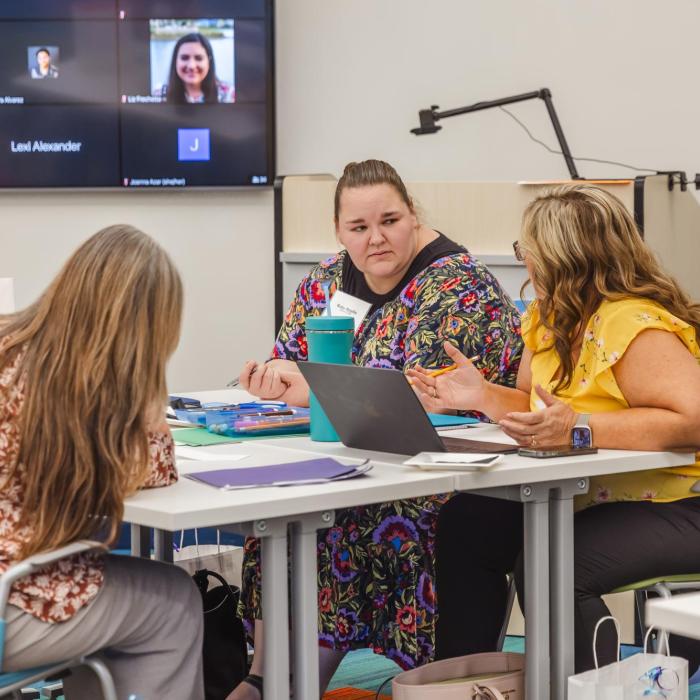Strengths
- Coachees spend more time with the coach and receive individualized support.
- Coaches focus on one coachee’s goals and needs at a time.
- Both coachees and coaches require less time to build a relationship.
This section offers a “Coaching Toolbox,” a set of strategies and resources you can use for early math coaching in your setting. This toolbox is not comprehensive. It offers select resources to support early math coaching. In this section, you will learn more about:
A coaching format describes the ways coaching is delivered. Let’s examine three types of coaching formats:
Let’s explore each coaching format’s strengths and limitations.
Strengths
Limitations
Strengths
Limitations
Strengths
Limitations
To learn more about coaching formats, you might visit the following resource from the National Center on Early Childhood Development, Teaching and Learning: Choosing a Coaching Format and Delivery Method.
Reflect:
What coaching format or formats might work best for your setting? Why?
As described earlier, early math coaching is a collaborative process. During coaching conversations, coaches and coachees seek to understand each other’s experiences and perspectives. One approach to ensuring a collaborative conversation is to use a cycle of three active listening skills called the “3 Ps”: pause, paraphrase, and probe.
Give the educator your undivided attention or quiet thinking time. Demonstrate active listening through body language, such as nodding or maintaining eye contact.
Acknowledge the educator’s feelings and ideas by repeating what they communicated in your own way.
Ask questions that invite deeper thinking and reflection. Probing also allows the coach to better understand the educator’s perspective, experiences, and current knowledge and skills.

Provide thinking time in a coaching conversation for yourself and others.
How to use this strategy:
Attend fully to the coachee by repeating what they communicated in a different way.
How to use this strategy:

Ask questions to increase clarity and understanding.
How to use this strategy:
Paraphrasing can be used for different purposes. Let’s explore examples of different types of paraphrasing.
“I’m really having a hard time with this class of students. Their ability levels are all over the place, and it feels like I have to plan six different lessons.”
“You’re concerned about planning for such a diverse group of children.”
“So, there seems to be two issues here: the wide range of performance levels in the class and the need to plan for each child’s needs.”
“You seem to value providing the appropriate level of learning for each child.”
Now it’s your turn to practice different ways of paraphrasing. Review the examples of coachees’ statements. Consider how you might paraphrase the coachee’s statement using one type of paraphrasing strategy. Use the sentence starters as a guide to craft your paraphrase:
“There are just so many demands on my time—meetings before and after work, professional learning communities (PLCs) on Monday mornings, schoolwide meetings on Wednesdays, and intervention team meetings on Thursday afternoons. I don’t have enough time to plan for my lessons or focus on my career development.”
“As a family child care provider who cares for multiple children ranging from two to seven years old, I want to make sure that each child’s needs are met. It sometimes feels challenging to plan learning experiences for each child. When we do activities together, I want all the children to have fun and learn something.”
“I found a great math unit online and a lot of helpful materials to use with my students who have learning disabilities. Why can’t I use these materials instead of the school-adopted math curriculum for teaching numbers and counting?”
Coachees come to coaching conversations with a variety of questions or concerns, comfort levels with math, and teaching experiences. Coaches use different roles, or coaching stances, to provide effective support during coaching conversations.
Use the Early Math Coaching Stances handout to explore examples of how early math coaches might take on different stances, or roles, to support educators' goals and needs.
Let’s learn more about each coaching stance.
Provides mental and emotional resources to best meet the coachee’s needs.
Matches the coachee’s strengths and opportunities for growth with their professional learning goals, plans, and content.
Identifies information, ideas, and technical resources that are most useful to the coachee.
Works with the coachee to create math learning experiences for children using the coach’s and the coachee’s areas of expertise.
Throughout this module, you explored various strategies and tools to build your capacity as an early math coach. The following list includes online and printable resources you can use to implement early math coaching in your setting.
In this module, you learned that coaching is an effective professional learning strategy that improves teaching and learning. Early math coaches can support educators to reflect on their teaching practice and enhance their math knowledge, skills, and mindsets.
Let’s revisit the module’s learning activities. In this module, you:
Reflect:
Now that you have learned about early math coaching, reflect on your role as an early math coach. What are some of your current areas of strength? What are some areas you would like to grow in?
As you explore the other Count Play Explore resources, consider ways you might use coaching to support educators’ learning.
For example, you might be interested in resources on specific math topics. If so, check out the Facilitator Resources.
You may also be interested in ideas for raising awareness of the importance of early math within your organization. If so, check out the Building Systems to Promote Early Math in Your Agency self-study module.
Modules for leaders, professional learning facilitators, and coaches to build their knowledge and skills in how to provide early STEAM professional learning.
Suites of resources on a range of early STEAM topics for facilitators and coaches to use in professional learning with educators.
Copy the link below to share this resource with students, families and colleagues, or to save for later.